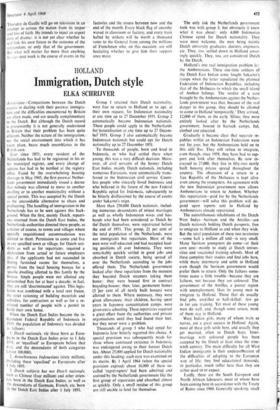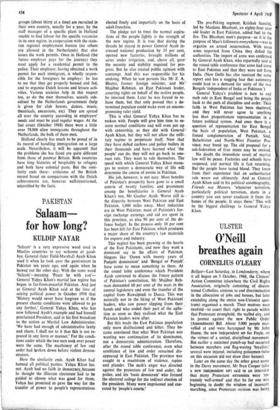Immigration, Dutch style
HOLLAND EMU SCHRIJVER
Amsterdam—Comparisons between the Dutch success in dealing with their postwar immigra- tion and the difficulties encountered by Britain are often made, and are usually complimentary to the Dutch. But although the Dutch record is praiseworthy it is not generally understood in Britain that their problem has been quite different. Neither the nature of the immigration,=- nor the social environment into which it has taken place, bears much resemblance to the British case.
Ever since 1851, every resident of the Netherlands has had to be registered in his or her municipal register, and every change of address has had to be notified at the registry office. Faced by the overwhelming housing shortage in May 1945, the first postwar Nether- lands government immediately issued a decree that nobody was allowed to move to another dwelling or to another municipality without a special permit. This was accepted by the Dutch as the unavoidable alternative to chaos and profiteering. The handling of immigration in the Netherlands has to be seen against this back- ground. When the first, mainly Dutch, repatri- ates returned from the Dutch East Indies, the Netherlands authorities directed these people, as a matter of course, to towns and villages where specially requisitioned accommodation was allotted to then. Permission to come and live in any specified town or village, for Dutch resi- dents as well as for repatriates, required a declaration from actual or future employers plus, if the applicants had not succeeded in finding furnished rooms for themselves, a permit from the local housing bureau for a specific dwelling allotted to this family by the bureau. Single people were not allotted any unfurnished flats for at least a decade; in fact, they are still 'discriminated' against. This legis- lation was combined with a total rent freeze, the strict rationing of building materials and subsidies, for contractors as well as for a re- stricted number of people with a permit to build their own home.
When the Dutch East Indies became the in- dependent Federal Republic of Indonesia in 1949, the population of Indonesia was divided as follow:
I. Dutch-nationals, viz those born as Euro- peans in the Dutch East Indies prior to 1 July 1893, or 'equalised' as Europeans before that date, and the descendants of both categories (about 300,000).
2. Antochtonous Indonesians (sixty million), including those 'equalised' as Europeans after 1 July 1893.
3. Dutch subjects but not Dutch nationals, such as Chinese (four million) and other orien- tals born in the Dutch East Indies, as well as the descendants of Germans, French, etc, born ' in the Dutch East Indies after 1 July 1893. Group I retained their Dutch nationality, were free to return to Holland or to opt, at their own request, for Indonesian nationality at any time up to 27 December 1951. Group 2 automatically became Indonesian nationals. . These people could apply to the Netherlands for:naturalisation at any time up to 27 Decem- ber 1951. Group 3 also automatically became Indonesian nationals but could opt for Dutch nationality up to 27 December 1951.
To thousands of people, born and bred in Indonesia, or who had settled there when young, this was a very difficult decision. More- over, all civil servants of the former Dutch East Indies, mainly Dutch nationals, including numerous Eurasians, were automatically trans- ferred to the Indonesian civil service. Count- less people who sincerely loved Indonesia and who believed in the future of the new Federal Republic opted for Indonesia, subsequently to be bitterly disillusioned by the course of events under Sukarno's reign.
More than 250,000 Dutch nationals, includ- ing numerous descendants of mixed marriages as well as wholly Indonesian wives and hus- bands who had been considered as Dutch by the' Dutch themselves, were repatriated before the end of 1951. This group, 2f per cent of the total population of the Netherlands, were not immigrants but repatriates. Most of the men were well educated and had occupied lead- ing positions all over Indonesia. They were remarkably quickly settled in good jobs and absorbed in Dutch society, being spread all over the Netherlands according to the jobs offered them. The Netherlands government looked after these repatriates from the moment they boarded Dutch steamers taking them home: they were housed first in contract boarding-houses; then, later, permanent homes (5 Per cent of all newly built houses) were allotted to them. Where necessary, they were given allowances; their children, having spent years in Japanese concentration camps, were given extra schooling. These repatriates required a great effort froni the authorities and private organisations until they had found their feet, but they never were a problem.
Thousands of group 1 who had opted for Indonesia later bitterly regretted this choice. A special provision was subsequently made for those whose continued existence in Indonesia was endangered owing to their former Dutch ties. About 25,000 applied for Dutch nationality under this heading; each case was examined on its merits. By 1 April 1964 (when the special provision expired) about 16,000 of these so- called 'regret-opters' had been admitted and assisted by the Netherlands government like the first group of repatriates and absorbed almost as quickly. Only a small residue of this group are still unable to fend for themselves.
The only risk the Netherlands government took was with group 3, but obviously- it knew
what it was about: only 4,000 Indonesian Chinese opted for Dutch nationality. They were most welcome, the men being mainly Dutch university graduates, doctors, engineers, etc. They, too, settled down in Holland amaz- ingly quickly. They, too, are considered Dutch by the Dutch.
Holland's one real immigration problem is: the Ambonesians. These one-time soldiers of the Dutch East Indian army fought Sukarno's troops when the latter repudiated the planned Federation pf Indonesian Republics, including that of the Moluccas to which the small island
of Ambon belongs. The verdict of a case brought by the Ambonesians against the Nether- lands government was that, because of the real danger to this group, they should be allowed to come to Holland 'temporarily.' They arrived, 12,000 of -them, in the early 'fifties; they were entirely looked after by the Netherlands government, housed in barrack camps, fed, clothed and educated.
Gradually it became clear that separate re- publics within an Indonesian Federation were out for ever, but the Ambonesians held on to this ideie 'rue. They still refuse to integrate, even though, since 1958, they have had to sup- port and lobk after themselves. By now in- creased to 27,000, they live in fifty-two newly built housing estates spread throughout the country. The obsession of a return to a free Republic of the Moluccas is kept alive even among the youngsters. An agreement with the new Indonesian government now allows Ambonesians to return to Ambon. Whether this repatriation—paid for by the Netherlands government—will solve this problem will de- pend upon reports sent to Holland by Ambonesians already repatriated.
The autochthonous inhabitants of the Dutch West Indies—Surinam and the Antilles—are Dutch nationals holding Dutch passports, free to emigrate to Holland as and when they wish. But the total population of these two territories —some half a million all told—is very small. Many Surinam youngsters do come—at their own cost—mainly to study at Dutch univer- sities and vocational training schools. Most of these complete their studies and find jobs here, while many intermarry and settle in Holland even though the Surinam government would prefer them to return. Only the failures some- times cause a little trouble—because they are failures, not because they are coloured. The government of the Antilles, a poorer region with unemployment, likes its young men to emigrate to Holland. Those that do usually find jobs, unskilled or half-skilled : few go in for any training. Yet most of these young men do well, and, though some return, most of them stay in Holland.
West Indian girls, many of whom train as nurses are a great success in Holland. Again, ' most of these girls settle here, and usually they get married, often to Dutch boys. Inter- marriage with coloured people has been accepted by the Dutch at least since the nine- tenth century. The main difficulty for all West Indian immigrants is their underestffnation of the difficulties of adapting to the European way of life; they find educational demands, in particular, much stiffer here than they are either used tetur expect.
Lastly, there are the South European and North African labourers, most of whom have been coming here in accordance with the Treaty of Rome since 1960. Generally speaking, small groups (about thirty at a time) are recruited in their own country, usually for a year, by the staff manager of a specific plant in Holland unable to find labour for the specific vacancies in its own region, in cooperation with the state. run regional employment bureau (no others are allowed in the Netherlands) that also issues the work permits. Once in Holland (the future employer pays for the journey) they must apply for a residential permit to the police. Their employer, having obtained a work permit for each immigrant, is wholly respon- sible for the foreigners he employs: he has to see that they get properly housed and fed, and to organise Dutch lessons and leisure acti- vities. Various societies help in this respect too, as do the men themselves, usually sub- sidised by the Netherlands government (help is given for club houses, dances, music, theatricals, excursions, etc). They are spread all over the country according to employers' needs and must be paid regular wages. At the last count (October 1968) there were a little over 78,000 alien immigrants throughout the Netherlands, the bulk of them men.
Holland clearly has much to be proud of in its record of handling immigration on a large scale. Nevertheless, it will be apparent that the problems she has faced are quite different from those of postwar Britain. Both countries have long histories of hospitality to refugees and both have colonial pasts. But the simi- larity ends there: criticisms of the British record based on comparisons with the Dutch achievements are, however well-intentioned, unjustified by the facts.



































 Previous page
Previous page